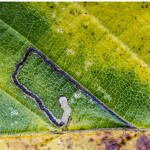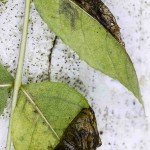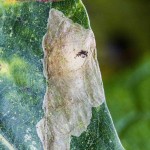Ian Sims led a joint field trip with the British Entomological and Natural History Society (BENHS) and the Berkshire Moth Group at Dinton Pastures Country Park, Winnersh on the morning of Saturday 11th October. Before starting the walk, Ian distributed hand-outs describing different sorts of leaf mines – galleries, blotches on upper or lower sides of leaves, folds and rolled up edges. He explained that many of the moths were hard to identify as adults but were much more easily identified as leaf mines. Many of the species are only found on a single host plant. The group set off along the road back towards the entrance, but progress was slow because immediately mines were found on lime, Norway maple, dog rose, Italian alder, hawthorn, ash and bramble. Turning into the quieter side road to the fishermen’s car park, more species were found on hornbeam, field maple and elm. A cone mine of Caloptilia syringella on ash was opened and found to have about 5 small wriggling larvae of different sizes. Ian explained that a significant proportion of the leaf miners are attacked by parasitoids. When some of the active mines were held up to the light, it was possible to see the tiny larva moving inside. Some larvae were yellow, some green, some brown. Ian pointed out how the start of the long gallery mine of Stigmella lemniscella on elm was very narrow, but it became wider at the points where the larva shed its skin and the next instar emerged. Not all the leaf mines were made by moths – Ian pointed out fly mines on Stinking Iris.
The group continued along the road as far as the next bridge, then turned off into a clump of white poplars, where one of the rarest species of the day was found. Phyllonorycter comparella makes barely-inflated blister mines on the underside of white poplar leaves. It is a moth with a limited range in Britain and is known from only a handful of sites in Berkshire. Most members of the Phyllonorycter family over-winter as pupae within their mines, but P. comparella over-winters as an adult. Jon Cole found 2 specimens of Crepidodera aurea, iridescent green flea beetles, on a poplar leaf. A green caterpillar of the Pale Prominent moth and a Dark Bush-cricket were also seen here. Next stop was an oak tree at the edge of an open area. When the mine of Tischeria ekebadella on an oak leaf was held up to the light, it looked like a blotch within a bigger blotch. A caterpillar of Bucculatrix ulmella came swinging down from on high, attached to a silken thread. The last tree to be examined was a willow, where the mine of Phyllocnistis saligna had yet another form. It started as a gallery in one leaf, continued down the leaf stem, along the branch and onto another leaf, where the moth pupated in the rolled-up leaf edge. The main walk ended back at the car park, but those who continued to the Wheelwrights Arms also saw Phyllonorycter platini on the plane tree outside the pub and the Firethorn Leaf-miner Phyllonorycter leucographella on the leaves of the Pyracantha bushes in the hedge around the café.
Pictures copyright Jon Cole



